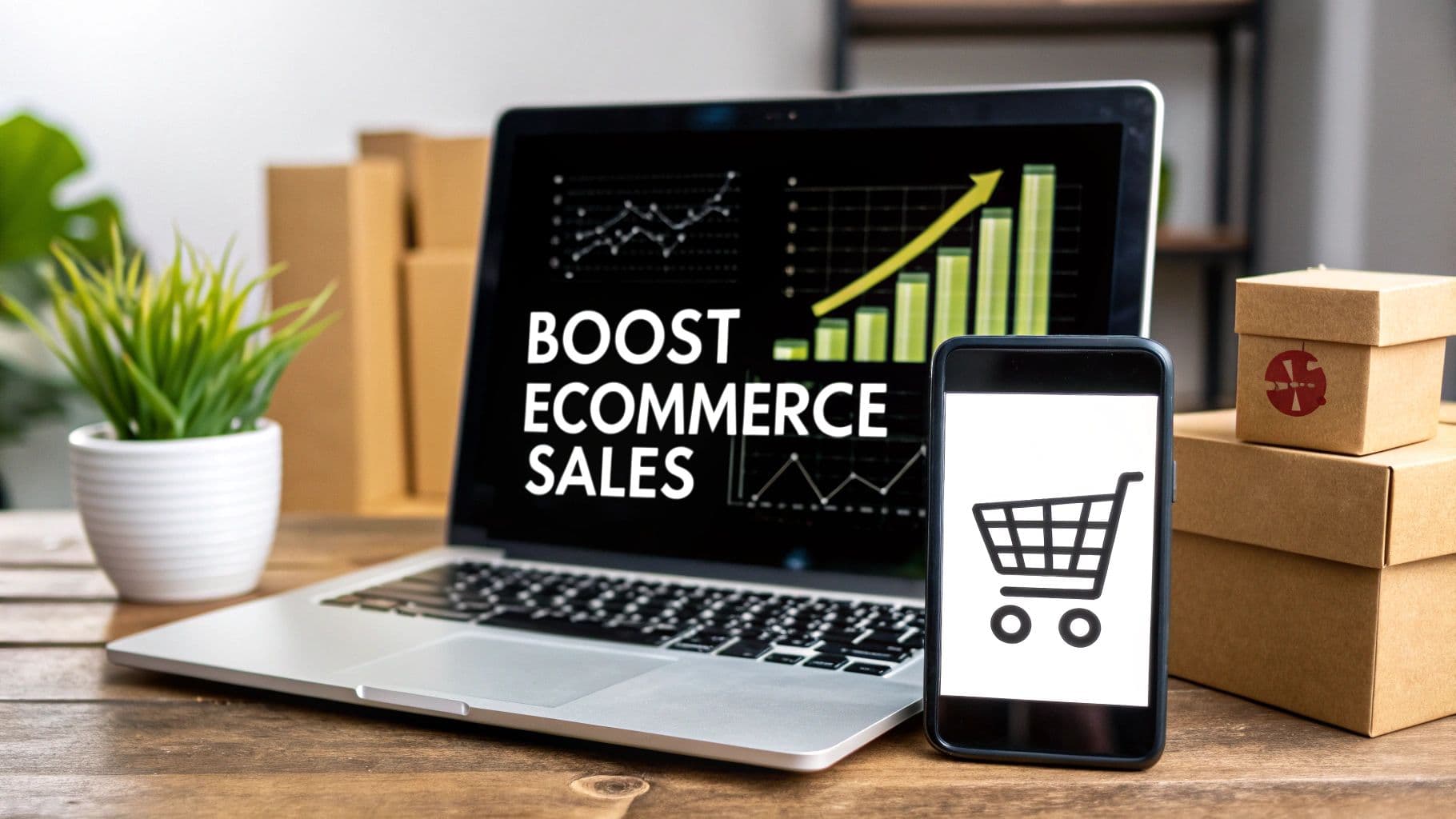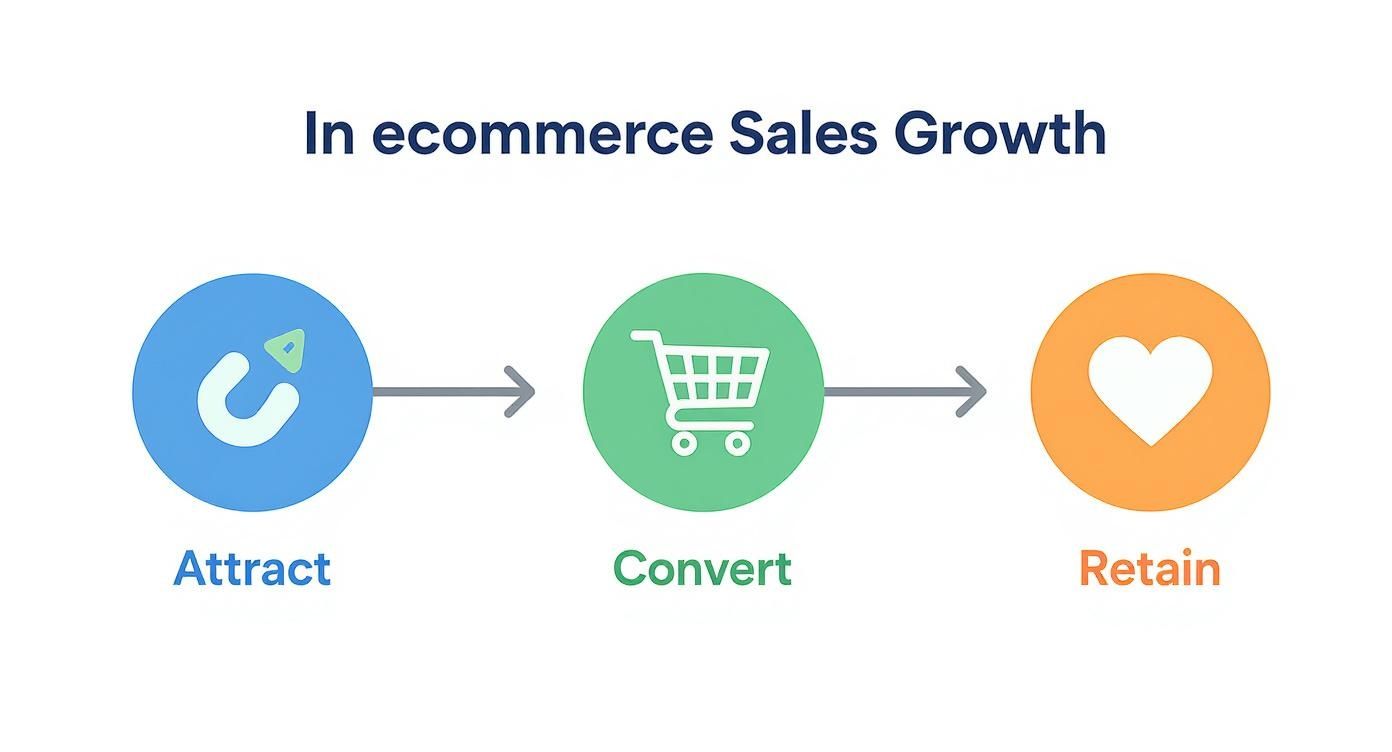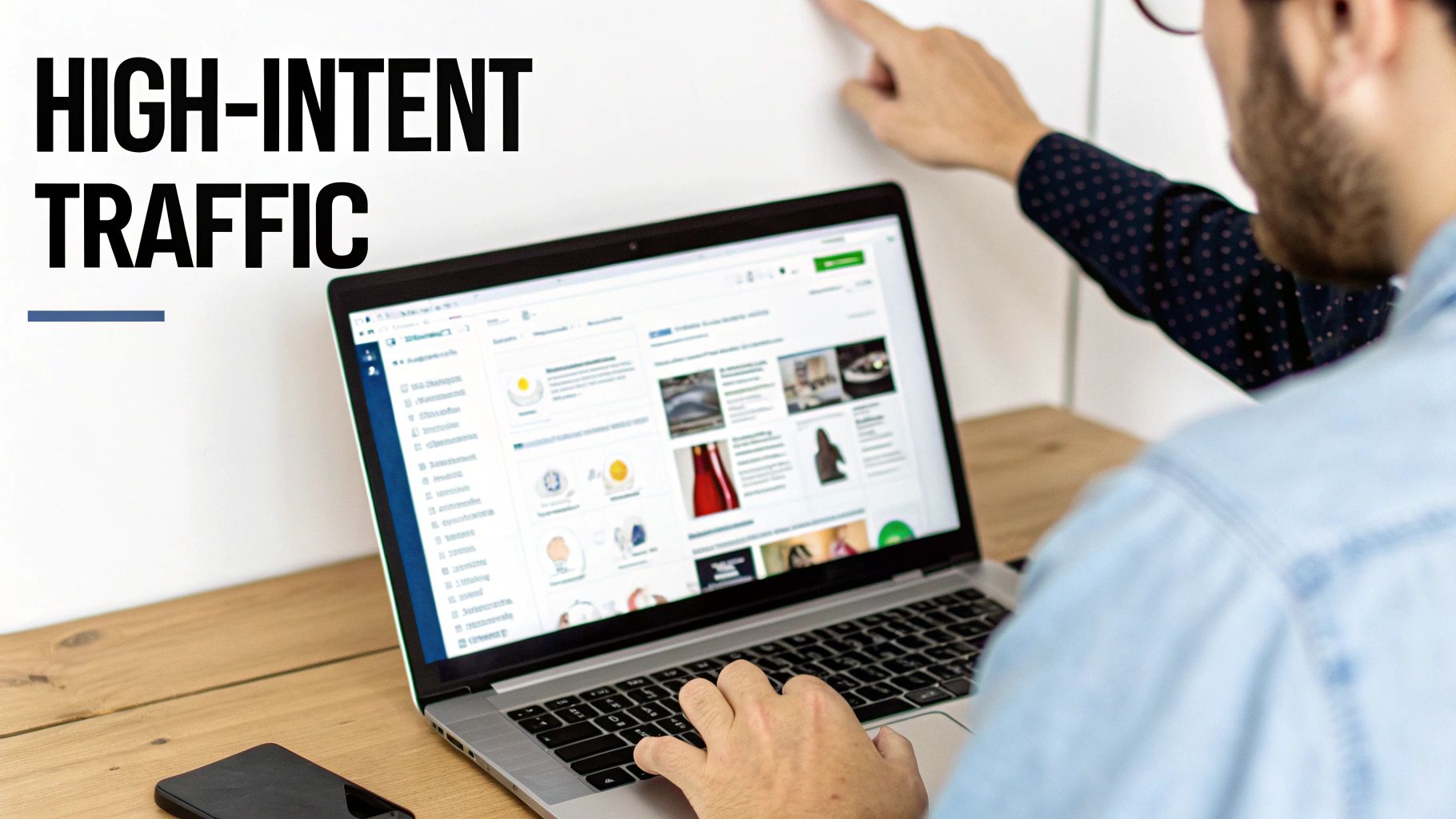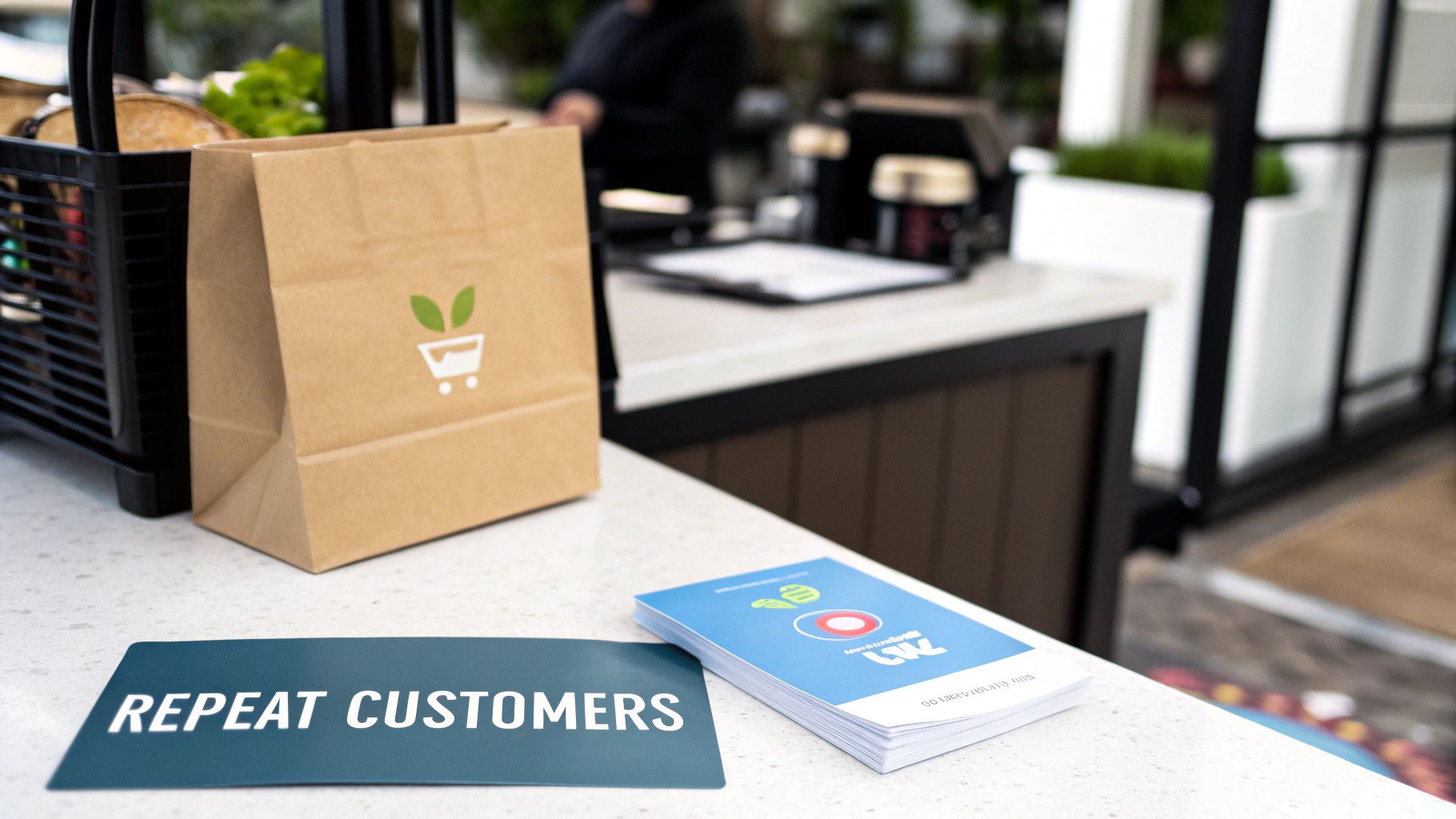
How to Increase Ecommerce Sales with Proven Tactics
Let’s get right to it. If you're looking to increase your ecommerce sales, you need to stop searching for that one magic bullet. It doesn’t exist. Real, sustainable growth comes from a well-oiled machine built on three core pillars: getting the right people to your site, turning them into customers, and keeping them coming back.
The Playbook for Real Ecommerce Growth
This isn't about abstract theories; it's a practical playbook for boosting your revenue. The most successful online stores understand that growth is a holistic process. It starts the moment someone sees your ad and continues long after their tenth purchase.
Focusing on just one area—like driving tons of traffic to a poorly designed website—is the classic "leaky bucket" problem. You can pour all the traffic you want into the top, but if your site experience is broken, you're just losing potential customers out the bottom.
This visual breaks down how these stages work together to create a powerful growth loop.

As you can see, each phase—Attract, Convert, and Retain—feeds directly into the next, creating a snowball effect that builds momentum and drives your revenue higher.
The Three Pillars of Ecommerce Sales Growth
The most successful brands are masters at making these three pillars work in harmony. While each requires its own set of tactics, they must blend seamlessly to create a customer journey that feels effortless and consistently leads to a sale.
Here’s a quick overview of what these pillars look like in action. This table breaks down the goal of each pillar and the key tactics you'll use to achieve it.
| Pillar | Primary Goal | Key Tactics to Implement |
|---|---|---|
| Traffic Acquisition | Bring qualified, high-intent buyers to your digital storefront. | SEO, Paid Ads (Google, Social), Content Marketing, Marketplaces |
| Conversion Rate Optimization | Turn website visitors into paying customers. | UX/UI improvements, A/B testing, compelling product pages, smooth checkout |
| Customer Retention & LTV | Turn one-time buyers into loyal, repeat customers. | Email marketing flows, subscription models, loyalty programs, great support |
This framework isn't just a to-do list; it's a strategic map for building a resilient and profitable online business.
The secret to increasing ecommerce sales is accepting there isn't one. The real win comes from disciplined, day-in-day-out execution and continuous improvement across these three fundamental pillars.
Building Your Action Plan
Treat this guide as your playbook for spotting weaknesses and seizing opportunities in your own business. For example, did you know that products with 5-star ratings have a 270% higher purchase rate? That single stat shows how a small element in the "Convert" pillar, like social proof, can have a massive impact on your bottom line.
To build a solid plan for the long haul, you'll need to explore actionable e-commerce growth strategies that fit your specific business.
Your ultimate goal is to create a system where your traffic acquisition efforts feed a high-converting website, which in turn builds a loyal customer base that drives repeat purchases and new referrals. That’s not just growth; that’s a sustainable business.
Driving High-Intent Traffic to Your Store

An online store without visitors is like a physical shop with the doors locked. To really move the needle on sales, you need more than just random clicks; you need a steady flow of people who are actually looking to buy. This is about building a smart, multi-channel strategy to attract high-intent shoppers, not just casual browsers.
The core of this strategy is figuring out where your best customers hang out online and what makes them tick. Are they searching for specific products on Google? Getting inspired by their Instagram feed? Or are they meticulously comparing prices on Amazon? A well-rounded approach means you're ready to meet them wherever they are.
Master Modern Ecommerce SEO
Search Engine Optimization (SEO) is your best bet for capturing free, "ready-to-buy" traffic around the clock. Think about it: when someone searches for "women's waterproof running shoes size 8," they're not just window shopping. They've got a problem to solve and their credit card is likely within reach. Your job is to make sure your product page is the answer they find.
To do this, you have to get laser-focused on commercial-intent keywords. These are the specific phrases that signal someone is deep in the buying cycle. Forget generic terms and dig into long-tail keywords that include product details like brand names, model numbers, colors, or specific uses.
Optimizing for these terms goes beyond just placing keywords on a page. It means taking care of the details that make you stand out in search results:
- Compelling Meta Descriptions: Write them like tiny ads. Make them interesting enough that a searcher has to click.
- High-Quality Product Images: Use crisp, professional photos. Don’t forget descriptive alt text, which helps both search engines and visually impaired users understand the image.
- Structured Data (Schema Markup): This is the code that powers those helpful rich snippets in Google—like star ratings, price, and stock status—right on the search results page.
Build a Profitable Paid Media Engine
While SEO is the long game, paid media is your sprinter. It delivers highly targeted visitors to your site, fast. Platforms like Google Ads and Meta (for Facebook & Instagram) let you put your products right in front of people who fit your ideal customer profile.
Profitability here all comes down to precision. On Google, for example, Performance Max campaigns are a powerhouse for ecommerce. They use machine learning to test your product ads across Google’s entire network—Search, Shopping, YouTube, you name it—to find the customers most likely to convert.
Over on Meta, you can build Lookalike Audiences from your existing customer email list. You're essentially telling the platform, "Go find me more people who look and act just like my best customers." This is an incredibly effective way to improve your ad relevance and get a much better return on ad spend (ROAS).
The whole point of paid advertising isn't just to get traffic—it's to acquire new customers at a cost that makes sense for your business. You absolutely have to track your Customer Acquisition Cost (CAC) for every channel and campaign. This is the only way to know where to double down and where to pull back.
Turn Social Followers into Active Buyers
Social media has grown up. It’s no longer just a place for brand updates; it's a full-fledged sales channel. Features like Instagram Shopping and Facebook Shops create a frictionless path from seeing a product to buying it, often without the user ever leaving the app.
This is all about tapping into the power of impulse. A user sees a product they love in their feed, and with a few taps, they can own it. To make this work, your content has to be authentic and stop the scroll.
- Showcase User-Generated Content (UGC): Actively encourage your customers to post photos with your products, then feature the best ones. Research shows a staggering 79% of people say UGC strongly influences their buying decisions.
- Work with Influencers: Partner with creators who your target audience already knows and trusts. Their endorsement can be the social proof needed to drive a sale.
- Go with Video: Use formats like Reels and Stories to show your products in action. A quick video demonstrating how a product solves a problem is infinitely more persuasive than a static product shot.
Mastering On-Site Conversion Rate Optimization

Getting traffic to your store is only half the battle. The real work—and where the money is truly made—begins when you turn those visitors into paying customers. This whole process is called Conversion Rate Optimization (CRO), and it's all about methodically ironing out the wrinkles in your website that cause people to leave.
Think of your online store like a physical one. If the aisles are a mess, the lighting is terrible, and nobody can find the checkout counter, people are going to walk out, no matter how great your products are. A confusing layout or a slow-loading page is the digital version of that exact same problem.
Build a Flawless Mobile-First Experience
Let’s get one thing straight: your CRO efforts should start with your mobile site, not your desktop one. Mobile commerce isn’t some future trend; it’s the here and now. With mobile ecommerce sales projected to hit $2.51 trillion globally in 2025—that’s a staggering 57% of all online sales—a clunky mobile experience is a surefire way to kill your business.
A mobile-first approach simply means you design for the smallest screen first, then scale up. This forces you to prioritize what's absolutely essential.
- Simplify Navigation: A clean, collapsible "hamburger" menu is your best friend. Make sure the search bar is front and center, ready for action.
- Optimize for Touch: Buttons and links need to be big enough for a thumb to tap easily. Nothing frustrates a user more than hitting the wrong link by mistake.
- Demand Lightning-Fast Speed: Every single second counts. A site that takes more than three seconds to load is already bleeding visitors.
The goal is to make buying on a phone feel completely natural, not like a frustrating chore. If your customer has to pinch, zoom, and fight with forms, you've already lost them.
Anatomy of a High-Converting Product Page
Your product page is your best salesperson. It’s where you have a shopper's full attention, and it has to do all the heavy lifting to convince them to hit "Add to Cart." Every single element needs to be scrutinized.
Visuals are everything. Since customers can't physically touch the product, your photos and videos have to do the work. High-resolution images from every angle, lifestyle shots showing the product in action, and short demo videos aren't optional anymore. In fact, 93% of customers say images are a key factor in their buying decision.
Once the visuals have them hooked, your copy needs to seal the deal.
- Compelling Descriptions: Don't just list features. Write copy that speaks to benefits. Show the customer exactly how your product will solve their problem or make their life better.
- Clear and Obvious CTAs: Your "Add to Cart" or "Buy Now" button should be impossible to miss. Use a color that pops and contrasts with the rest of the page.
- Social Proof and Trust Signals: Display customer reviews, star ratings, and trust badges (like secure payment logos). People trust other shoppers far more than they'll ever trust your marketing copy.
The Discipline of A/B Testing
So, how do you really know if a green "Buy Now" button works better than an orange one? You don't guess—you test. This is what A/B testing (or split testing) is all about: showing two different versions of a page to different groups of visitors and seeing which one performs better.
This data-driven method takes all the guesswork and ego out of your optimization process. For a deeper dive, our guide on how to improve ecommerce conversion rates offers a more structured approach.
Start with tests that can give you big, meaningful results. Forget about testing tiny font changes at first. Instead, focus your initial experiments on high-impact areas:
- Headline Variations: Test completely different value propositions. Which one grabs your audience's attention?
- Call-to-Action Text: Does "Get Started" convert better than "Sign Up Now"? The only way to know for sure is to test it.
- Product Page Layouts: Try a completely different arrangement of your images, descriptions, and reviews.
- Offer Presentation: Test how you frame your pricing. Is "20% Off" more powerful than "$10 Off"?
Sticking with a disciplined A/B testing routine creates a powerful cycle of continuous improvement. It ensures your site is always evolving to meet customer needs and, ultimately, drive more sales.
Optimizing Your Checkout and Payment Experience
The checkout page is the final hurdle. It’s the make-or-break moment where all your hard work attracting a customer and showing them the perfect product pays off—or doesn't. A clunky, confusing, or untrustworthy process is the number one reason why nearly 70% of online shopping carts are left behind.
Think about that. It’s not just a small leak; it's a massive hole in your revenue bucket. Fixing your checkout is one of the fastest ways to boost sales without spending a single extra cent on ads. The mission is simple: make paying so easy and secure that customers don't even have to think about it.
Eliminate Friction with Express Checkouts
We live in a world of one-click convenience. Forcing a customer to painstakingly type in their name, address, and credit card details feels like a relic from the past. Every single field they have to fill out is another chance for them to get distracted or have second thoughts.
This is where express payment options become your secret weapon.
Integrating digital wallets like Apple Pay, Google Pay, and Shop Pay is no longer a nice-to-have feature; it’s an absolute must. These services keep a customer's payment and shipping info on file, letting them buy something with just a fingerprint or facial scan.
Imagine a customer browsing your site on their phone during a busy commute. They find something they love but don't have their wallet handy.
- Without Express Pay: They add the item to their cart, planning to buy it later. Of course, life gets in the way, and they completely forget. Sale lost.
- With Express Pay: They tap the Apple Pay button, confirm with Face ID, and the order is placed in under ten seconds. You just won a customer.
By getting rid of the biggest point of friction—manual data entry—you’re meeting the modern, mobile-first shopper exactly where they are.
The best checkout experience is one the customer barely remembers. It should feel invisible. The more seamless and instant you can make the transaction, the higher your conversion rate will be.
For a deeper dive into this crucial stage of the buying journey, check out our guide on how to reduce cart abandonment for more practical strategies.
Embrace Alternative Payment Methods
Your customers aren't all the same. Different people have different financial habits, and if you only accept traditional credit cards, you’re basically telling a huge chunk of potential buyers you don't want their business.
Broadening your payment options is a direct line to capturing more of the market.
Buy Now, Pay Later (BNPL) services like Klarna and Afterpay have become incredibly popular, especially with younger shoppers. They let people split a purchase into smaller, interest-free payments, which makes bigger-ticket items feel much more affordable. This can give your Average Order Value (AOV) a serious lift by removing the sticker shock of a large upfront cost.
Beyond BNPL, accepting cryptocurrencies can pull in a whole new, tech-savvy audience. Integrating a solid crypto payment gateway opens your doors to a global customer base that values security, privacy, and low transaction fees. It’s a clear signal that your brand is modern and willing to meet customers on their terms.
Turning Buyers Into Loyal Brand Advocates

The sale is just the beginning. The real work—and the real profit—starts after the customer clicks "buy." It's tempting to focus all your energy on finding new customers, but the truth is, it costs far more to acquire a new one than to keep an existing one happy. This is where you pivot from a one-time transaction to a long-term relationship.
Your most valuable customer is the one you already have. The post-purchase experience is your golden opportunity to build a connection that lasts, creating genuine fans who not only come back for more but also tell their friends about you. This doesn't happen by accident; it's the result of a deliberate strategy built on communication, value, and community.
Build Automated Post-Purchase Email and SMS Flows
Your job isn't over when the shipping confirmation email goes out. In fact, that's the perfect time to kickstart the next conversation. Smart, automated email and SMS flows are like having a 24/7 retention team working behind the scenes to nurture relationships and even recover lost revenue. These aren't just generic marketing blasts; they're timely, personalized messages triggered by real customer actions.
At a minimum, every ecommerce store should have these automated flows running:
- Abandoned Cart Recovery: This is non-negotiable. A simple, multi-step reminder about what they left behind can work wonders. Create a little urgency, maybe even sweeten the deal with a small, time-sensitive discount.
- New Customer Welcome Series: Don't just send a receipt and call it a day. Roll out the red carpet with a series of emails that tells your brand story, highlights other products they might love, and offers a small thank-you discount for their next purchase.
- Win-Back Campaigns: Re-engage customers who haven't purchased in a while (say, 90 days). A friendly "We miss you!" email with a compelling offer can be all it takes to bring them back into the fold before they're gone for good.
The real power here is in the automation. Once you set these up in a tool like Klaviyo or Mailchimp, they consistently engage customers at the most critical moments, driving repeat business without you lifting a finger. This proactive communication helps you solve a major business problem; check out our guide on how to reduce churn for more actionable insights: https://blockbee.io/blog/post/how-to-reduce-churn
Create Predictable Revenue with Subscriptions
If you sell products that people use up and re-buy—think coffee, skincare, pet food, or vitamins—a subscription model can be an absolute game-changer. Subscriptions turn unpredictable, one-off sales into a steady, reliable stream of recurring revenue. Suddenly, forecasting your finances becomes a whole lot easier.
Implementing a "Subscribe & Save" option does more than just lock in future sales. It's a huge value-add for your customers, giving them convenience and cost savings in one package. They never have to worry about running out, and they get a better price for their loyalty. You’re not just selling a product; you’re building a habit around your brand.
Design Loyalty Programs That Build Community
A great loyalty program isn't just a digital punch card. It’s a powerful tool for building a genuine community around your brand, making customers feel like they're part of an exclusive club. While basic points-for-purchase systems are a good start, the best programs use tiers to give customers something to strive for.
Think about a tiered system where the perks get better as customers climb the ladder:
- Bronze Tier (Entry Level): Basic points on every purchase.
- Silver Tier (Mid-Level Spenders): Early access to sales and new products, bonus points events.
- Gold Tier (Your VIPs): Free shipping on everything, exclusive access to limited-edition items, maybe even a dedicated customer service line.
Perks like these make your best customers feel seen and appreciated, giving them every reason to stick with you. To really supercharge this, you can formalize these relationships by creating a dedicated brand advocate program that turns your biggest fans into your best marketers.
This strategy is especially powerful when you consider where ecommerce sales are concentrated. Over 80% of global ecommerce activity happens in just three regions: China, the United States, and Western Europe. These markets collectively generated over $5.17 trillion in ecommerce sales in 2025. With the U.S. market alone projected to hit $1.47 trillion in 2025, building strong customer loyalty in these key areas can have a massive impact on your bottom line.
Common Questions About Increasing Ecommerce Sales
Diving into ecommerce growth always brings up a ton of questions. Let's walk through some of the most common ones I hear from store owners who are looking for real, practical ways to get more sales. My goal here is to give you direct, actionable advice you can put to work immediately.
What Are the Quickest Ways to See a Sales Increase?
Look, we all want sustainable, long-term growth. But sometimes you just need a quick win to get the ball rolling and build momentum. If you're looking for tactics that deliver faster results, here's where I'd start.
One of the most direct routes is a highly targeted paid ad campaign. I'm not talking about a broad, "get our name out there" campaign. I mean a surgical strike. Focus on your absolute best-selling products with a Google Shopping campaign or a Meta campaign aimed at a lookalike audience of your best customers. This drives immediate, high-intent traffic right where you want it.
Another powerful move is to create a genuine sense of urgency.
- Run a Flash Sale: A 24-hour sale on a popular category can work wonders. The fear of missing out (FOMO) is a real, powerful motivator for shoppers who are on the fence.
- Offer a Compelling Discount: A clear, attractive discount for first-time buyers or for orders over a certain threshold can be that final nudge someone needs to click "buy."
Finally, one of the fastest wins is often found right at the finish line—your checkout. Just by enabling guest checkout and adding express payment options like Apple Pay or Shop Pay, you can instantly remove major roadblocks for people who are ready to give you their money.
How Important Is Mobile Optimization?
It’s not just important; it’s everything. Thinking of mobile as an afterthought is a surefire way to leave a staggering amount of money on the table. We’ve moved way past mobile being a "nice-to-have." It's now the primary way most people shop online.
A slow, clunky, or confusing mobile site is a direct cause of lost sales. Full stop.
Your site absolutely must load quickly, be easy to navigate with a thumb, and present information clearly on a small screen. If a customer has to pinch, zoom, and struggle to fill out a form, they won't just get frustrated—they'll leave and buy from your competitor in a heartbeat.
Considering that mobile commerce is projected to account for the majority of total ecommerce sales, neglecting a mobile-first design means you are willingly turning away most of your potential customers. It's one of the highest-impact investments you can make for your business.
Should I Sell on Marketplaces Like Amazon?
This is a big one. Selling on marketplaces like Amazon or Etsy can be an incredibly powerful channel, but it’s a strategic decision that comes with real trade-offs. You have to weigh them carefully against your brand's goals.
The main advantage is undeniable: you get immediate access to a gigantic audience of people who are there to shop. Tapping into a platform like Amazon can dramatically boost your sales volume and introduce your brand to customers who might never have found your website. It's an amazing tool for customer acquisition.
However, that access comes at a price.
- Steep Fees: You're going to pay significant commission fees on every single sale, which eats directly into your margins.
- Less Control: You have far less control over your branding, the customer experience, and your direct relationship with the buyer.
- Fierce Competition: You'll be sitting right next to your biggest competitors, which often turns into a race to the bottom on price.
For many brands, a smart hybrid strategy works best. Use the marketplace to get that first sale and win a new customer. Then, use great packaging, inserts, and thoughtful follow-up emails to bring that person back to your own website for their next purchase. This approach lets you use the marketplace's massive reach while building more profitable, direct relationships for the long run.
Ready to expand your payment options and capture a new segment of tech-savvy customers? BlockBee makes it simple to accept over 70 cryptocurrencies with a secure, non-custodial gateway that integrates seamlessly with your existing ecommerce platform. Start accepting crypto payments today at https://blockbee.io.
